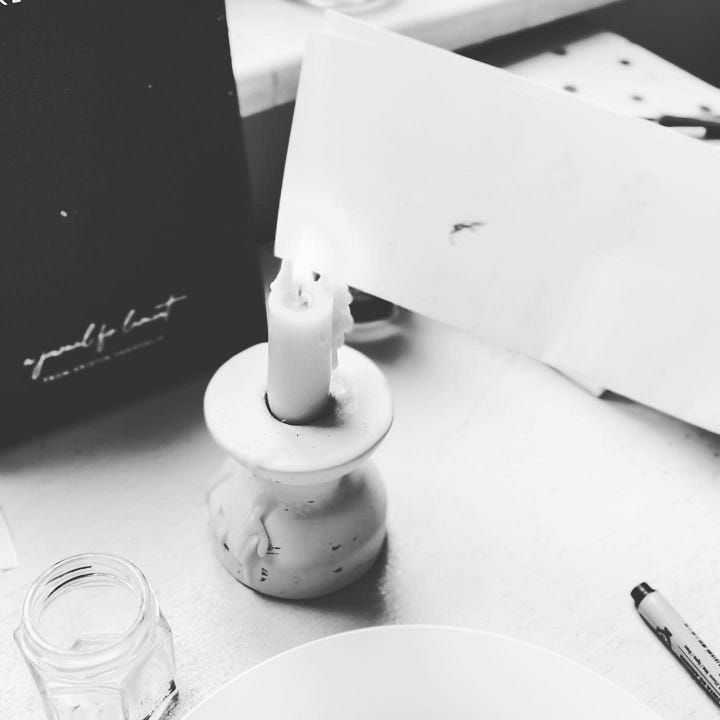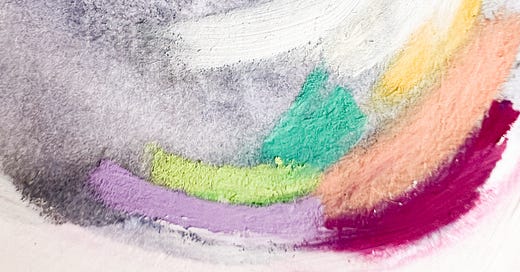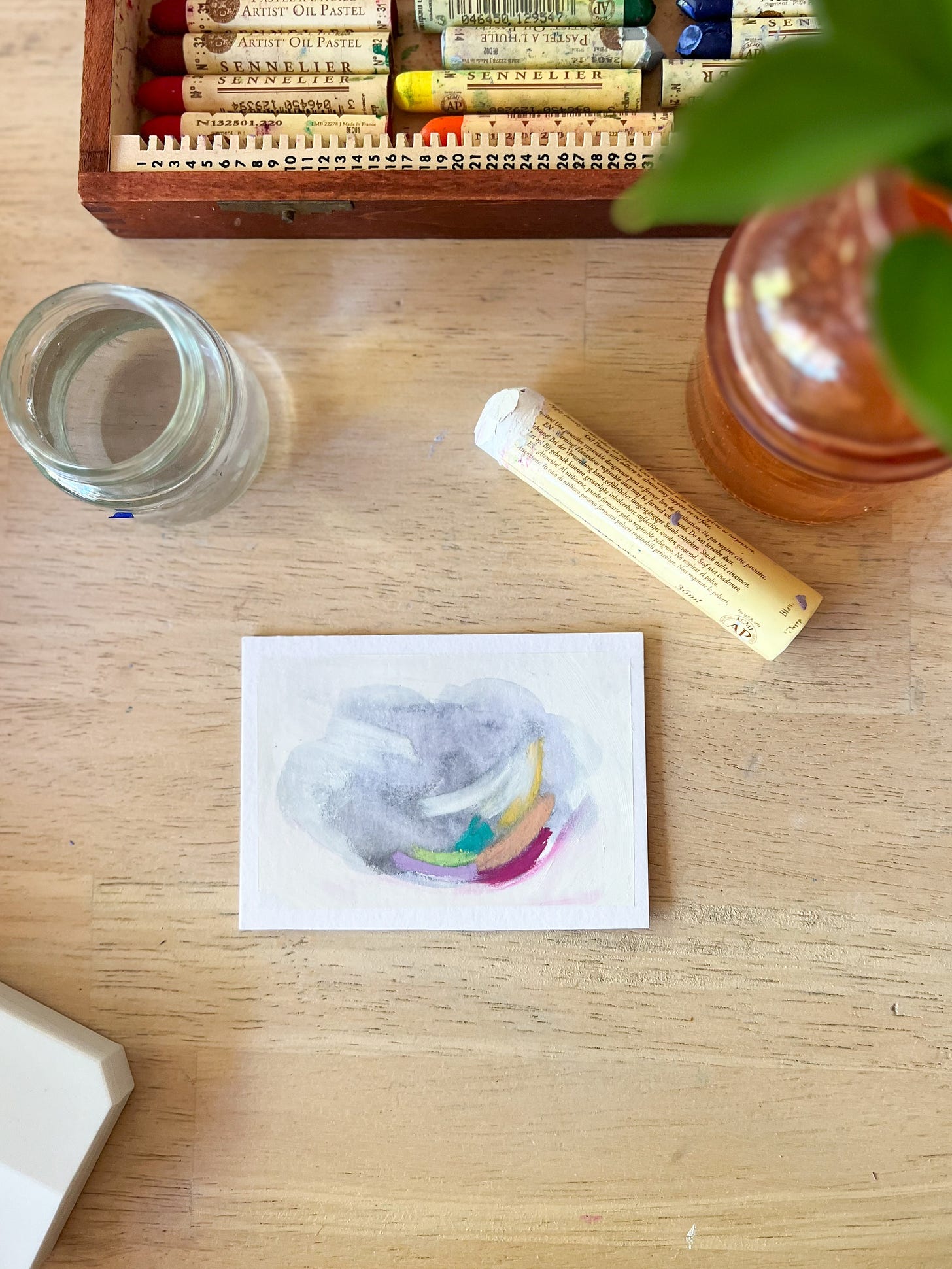Sifting Through Ashes & Spiritual Beliefs [Plus, A Creative Practice]
Revisiting Religious Traditions, Healing from Self-Abhorrence, and Embracing a Season of Preparation
A History of Ash
On this Ash Wednesday, I revisit my blurred childhood memories of our priest gently smudging ash across my forehead with his thumb. He was an older gentleman, mostly bald with some white hair, tall, and very Fred Rogers-like—authentically warm and generously kind. In my young faith, I wore this mark with a sense of pride and belovedness—a mark of being beloved by God. In some ways, I felt special walking about in the ordinary world with a sacred ashen cross on my face.
Growing up in the Catholic faith tradition that I did, I became very familiar with sin and the formal practices of confession, repentance, and forgiveness. As I grew older, I stepped into a less traditional, more evangelical sphere of Christianity. I’m not sure exactly when, where, or how, but over time, I internalized a belief system rooted in self-denial, self-sacrifice, selflessness, and ultimately, self-hatred.1
As suffering crashed into my adult life, I became immersed in grief, and my spirit fell into deep darkness—a deep nothingness—at times.2 This coincided with evangelical messages preaching abundance and prosperity to those who devoted their lives to Christ. My life experiences didn’t fit their theological formulas. Though I experienced an intimate awareness of God’s presence in my suffering, I began to feel like an outsider within evangelical communities. Eventually, I found solidarity and companionship for this part of my spiritual journey in the book and life of Job.3
I didn’t experience an unraveling of my faith but rather an unraveling of false beliefs and harmful narratives. I don’t recall ever believing God hated me or found me deplorable, even in the depths of my despair and although I’d come to inherit these beliefs about myself. However, I can still hear a haunting voice out in the world spreading hate through the ashes.
I’ve shared various versions of this before, and I return here again, not only because it’s part of my life’s story but because, at the start of the Lenten season, the ashes bring me back. Back to the ashes painted on my forehead by the kind priest’s thumb. Back to the ashes left behind after seasons of suffering burned through my life. Back to the aches that have come with the various meanings and encounters with ash and abhorrence.
Perhaps I’m at a point of addressing and arriving at an answer to the question: Are humans inherently evil, or are they inherently good and loved by God? I’m growing aware that I once dwelt in the theological camp of total depravity. While I continue to hold certain beliefs about evil, sin, and such as real, I believe that all people are created in God’s image and beloved at their core.
I’m no theologian, but my spirituality is inseparable from who I am and what I do. My experiences and suffering have shaped my understanding of faith, healing, and love. And just as deeply, my creativity is woven into my spirituality—it cannot exist apart from it—and through this intersection, a deep inner healing and path to hope.
Revisting, Reimagining, + Realigning
I want to reshare some revised words and a creative practice I originally shared on Ash Wednesday back in 2023:
“I have witnessed words like dust and ash weaponized to deem one worthless—to declare one nothing. In response, I wrote this haiku.
Don’t let the words twist
Your dust shines with Heaven’s kiss
He calls you by name
He doesn’t call you nothing. From nothing, He calls you. He creates you. From dust, the Creator, the Potter, created YOU and calls YOU good. He calls you more than good. He calls you by name. His holy breath lives in you.”
This Lenten season, I want to live with a healthy spiritual view of myself as God sees me and continue to learn from and embody Jesus’s ways. I want to embody God’s deep love and resurrecting power while engaging in practices that put to death all that opposes that love. And I want to cultivate a healthy humility and honest reverence.
I want the ashes to name the aches and align me with Love.
Though certain religious dates, practices, and communities can stir up complicated emotions and past traumas, I am grateful for the intentional space they create—for weeping, waiting, and preparation—before celebration (e.g., Advent before Christmas and Lent before Easter).
I also want to encourage those of us wondering what the Lenten season means or looks like to consider the following questions: Can we mourn, lament, and repent for the ways of hate, death, and destruction moving through the world?4 Can we witness the weeping of the world? Can we repent of the wrongs and wounds we have contributed while also healing from the ones inflicted upon us? Can we love one another and ourselves more fully alive?
How can we take what feels like ashes—our wounds or destructive beliefs—and allow God to reshape them into something new?
May this be a season where we not only contemplate but create, transforming what was into what can be.
A Creative Practice — Transform Ashes into Art


This revisited practice invites you to release harmful narratives or distorted beliefs about yourself and reshape them into something new and beautiful. If you try this and feel open to sharing, I’d be honored to see what you create.
Take a piece of paper and write down words that have wounded you—beliefs that have birthed self-hatred.
Very carefully burn the piece of paper and repent for believing those harmful narratives.
Collect the ashes in a small container. (Optional: Add water to create a paint of sorts).
Take a new piece of paper and “paint” something new with the ash—either smear the chalky dust on the page with your finger or use a paintbrush to paint the mixture onto the page.
Add additional artistic mediums (paint, marker, pastels) and colors to the paper. From the dust and ash, create something new.
More Words to Explore
Here are some additional words I’m sitting with this season that I invite you to explore as you sift through your spiritual beliefs and ‘ashes’ this Lenten season:
From Pen & Mend Prompt No. 7 by me
…I sort of love the second half of the definition of repent: '‘to the amendment of one's life.'‘ It calls to mind what we're here to do together through Pen & Mend. We're here to mend our lives and use the words we write to weave a story of Hope for ourselves.
From “One of the Best Writing Prompts I know” by Stephanie Duncan Smith
“Lent” means “spring” and while this is a penitential season in the Christian tradition, it also parallels the natural season of the earth coming alive again. Every day, the light stretches longer. Ice is melting, green is returning, life is on its way. I see this time as a very both/and season, spacious enough to both name our mortality and usher life and renewal on its way.
From A Cry for Mercy by Henri Nowen
How often have I lived through these weeks without paying much attention to penance, fasting, and prayer? How often have I missed the spiritual fruits of the season without even being aware of it? But how can I ever really celebrate Easter without observing Lent? How can I rejoice fully in your Resurrection when I have avoided participating in your death? Yes, Lord, I have to die—with you, through you, and in you—and thus become ready to recognize you when you appear to me in your Resurrection. There is so much in me that needs to die: false attachments, greed and anger, impatience and stinginess…. I see clearly now how little I have died with you, really gone your way and been faithful to it. O Lord, make this Lenten season different from the other ones. Let me find you again. Amen.
From Whistling in the Dark by Frederick Buechner
In many cultures there is an ancient custom of giving a tenth of each year's income to some holy use. For Christians, to observe the forty days of Lent is to do the same thing with roughly a tenth of each year's days. After being baptized by John in the river Jordan, Jesus went off alone into the wilderness, where he spent forty days asking himself the question what it meant to be Jesus. During Lent, Christians are supposed to ask one way or another what it means to be themselves… It can be a pretty depressing business all in all, but if sackcloth and ashes are at the start of it, something like Easter may be at the end.
This month’s journaling prompt is an invitation to explore and heal self-hatred. This prompt will go live on Sunday, March 9th, in the Pen & Mend tab. Become a paid subscriber for full access (free subscribers will be able to read a preview).
Also known as dark nights of the soul.
Several years ago, I created a Lenten reading plan and study of the book of Job called Deeper Still. You can find these as free PDF downloads at the bottom of my shop in the freebie section: https://kristinvanderlip.com/shop.
I’d be remiss if I didn’t offer a reminder of the resource I created to help you engage with the practice of written lament: the journal I created, Rest.









Thank you Kristin for your powerful words and insights, always.